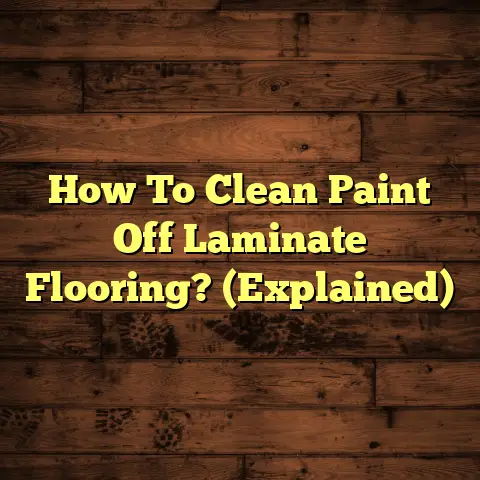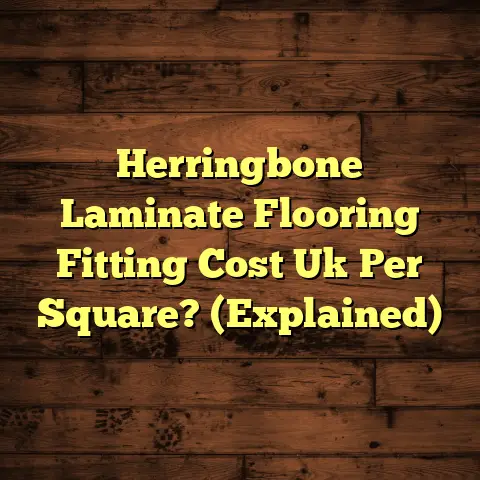Gym Mats for Carpet: Protect It! (4 Must-Haves!)
I’m a flooring contractor, and I’ve seen it all – from pristine hardwood to carpets that have faced the wrath of home workouts.
The rise of in-home fitness is fantastic. But let’s be real: your carpet might be screaming for mercy.
That’s where gym mats come in.
But not just any gym mat will do the trick.
We need to think strategically about protecting your carpet while you crush those fitness goals.
Over the years, I’ve seen some incredible advancements in gym mat technology.
We’re talking innovative materials, smart designs, and features that actually make a difference.
No more flimsy mats that slide around or wear out after a few weeks.
These mats are designed to withstand serious use and protect your investment.
In this article, I’m going to break down the four must-have features that will ensure your gym mat does its job – protecting your carpet and providing a safe, effective workout space.
We’re talking material quality, thickness and density, non-slip features, and size/customization.
Ready to dive in? Let’s get started!
Section 1: Material Quality – The Foundation of Protection
Alright, let’s talk materials.
This is where it all begins. Think of the material as the foundation of your carpet’s protection.
You wouldn’t build a house on a weak foundation, right?
Same goes for your gym mat.
The materials used in gym mats impact everything, from durability and comfort to how well they protect your carpet.
I’ve seen mats made from all sorts of stuff – PVC, rubber, foam, and even some newer eco-friendly options.
Let’s break down the most common ones.
-
PVC (Polyvinyl Chloride): PVC mats are often more affordable, but they can be less durable and might not provide the best cushioning. I’ve noticed they can also have a slightly plastic-y feel, which some people don’t love.
-
Rubber: Rubber mats, especially those made from recycled rubber, are incredibly durable and offer excellent shock absorption. They’re a great choice for heavy-duty workouts. The downside? They can be heavier and sometimes have a distinct rubber smell.
-
Foam (EVA or Memory Foam): Foam mats are typically more comfortable and lightweight. EVA foam is a popular choice for its cushioning properties, while memory foam provides even more support. However, foam mats might not be as durable as rubber, and they can be more prone to indentation over time.
How Material Impacts Carpet Protection
So, how do these materials actually protect your carpet?
Well, it’s all about preventing wear and tear.
Think about it: every time you jump, lunge, or plank, you’re putting pressure on your carpet fibers.
Over time, this can lead to flattening, matting, and even permanent indentations.
High-quality materials act as a buffer, absorbing the impact and distributing the weight more evenly.
This reduces the direct pressure on the carpet fibers and helps prevent damage.
I’ve seen firsthand how a good rubber mat can save a carpet from looking like a war zone after just a few months of intense workouts.
Comparison of Materials
| Material | Advantages | Disadvantages | Carpet Protection | Grip | Maintenance |
|---|---|---|---|---|---|
| PVC | Affordable | Less durable, may feel plastic-y | Moderate | Fair | Easy to clean |
| Rubber | Very durable, excellent shock absorption | Heavier, may have a rubber smell | Excellent | Good | Easy to clean |
| Foam | Comfortable, lightweight | Less durable, prone to indentation | Good | Fair | Requires more care |
Innovative Materials
Now, let’s talk about some of the newer materials hitting the market.
One trend I’m seeing is the rise of eco-friendly options.
Some manufacturers are using recycled materials or plant-based foams to create mats that are both durable and sustainable.
I’m also seeing mats with antimicrobial properties, which is a huge plus for hygiene.
I recently installed a mat made from a blend of recycled rubber and cork. The client was thrilled with the look and feel, and I was impressed with its durability and eco-friendliness.
My Recommendation
If you’re serious about protecting your carpet, I recommend opting for a rubber or high-density foam mat.
Yes, they might be a bit pricier, but the investment is worth it in the long run.
You’ll get better durability, better shock absorption, and ultimately, better carpet protection.
Section 2: Thickness and Density – Cushioning for Victory
Alright, let’s get into the nitty-gritty of thickness and density.
These two factors are crucial for both comfort and carpet protection.
Think of it this way: thickness is like the overall padding, while density is how well that padding holds up under pressure.
Understanding Thickness
Why does thickness matter, especially on carpet?
Well, carpet already provides some cushioning, but it’s usually not enough for high-impact exercises.
A thicker gym mat adds an extra layer of protection, absorbing more of the impact and reducing the stress on your carpet fibers.
I’ve seen people try to get away with thin yoga mats on carpet, and let me tell you, it’s not a pretty sight.
Over time, the carpet underneath gets flattened and matted, and you might even end up with permanent indentations.
Density’s Role in Performance
Now, let’s talk about density.
Density refers to how tightly packed the material is.
A denser mat will be more resistant to compression and deformation over time.
This is crucial for protecting your carpet because it prevents the mat from bottoming out and transferring the impact directly to the carpet fibers.
I’ve tested mats with different densities by placing heavy weights on them for extended periods.
The denser mats showed minimal compression, while the less dense mats flattened out significantly.
Choosing the Right Thickness
So, how do you choose the right thickness for your needs?
Well, it depends on a few factors:
-
The type of carpet you have: Thicker carpets generally require thicker mats for adequate protection.
-
The intensity of your workouts: High-impact exercises like jumping jacks and burpees require thicker mats than low-impact activities like yoga or Pilates.
-
Your personal preferences: Some people prefer a firmer surface, while others prefer more cushioning.
As a general rule of thumb, I recommend a mat that is at least ½ inch thick for most carpeted surfaces.
If you have a very thick or plush carpet, you might want to go even thicker.
Innovative Thickness Solutions
I’m seeing some interesting innovations in thickness customization.
One trend is modular mats, which allow you to add or remove layers of padding to customize the thickness to your liking.
This is a great option if you have different workout areas with different carpet types.
I recently installed a modular mat system in a home gym, and the client was thrilled with the ability to adjust the thickness based on the exercise they were doing.
My Recommendation
When it comes to thickness and density, don’t skimp.
Invest in a mat that is thick enough and dense enough to provide adequate cushioning and support.
Your carpet (and your body) will thank you.
Section 3: Non-Slip Features – Safety First!
Okay, let’s talk about something that’s super important: non-slip features.
This isn’t just about protecting your carpet; it’s about protecting you.
A slippery gym mat can lead to serious injuries, especially when you’re doing dynamic exercises.
Significance of Non-Slip Design
Working out on carpet can be tricky.
The carpet fibers can create a slightly uneven surface, which can make it easier for your mat to slip and slide around.
That’s why it’s essential to choose a mat with excellent non-slip properties.
I’ve seen too many people wipe out during home workouts because they were using a mat that didn’t have enough grip.
Trust me, it’s not a fun experience.
Types of Non-Slip Technologies
So, what makes a gym mat non-slip?
Well, there are a few different technologies and design features that can improve grip and stability.
-
Textured Surfaces: Many mats have textured surfaces that provide extra traction. This can be anything from a subtle diamond pattern to a more aggressive ribbed design.
-
Anti-Slip Coatings: Some mats are treated with special anti-slip coatings that enhance grip. These coatings can be made from rubber, silicone, or other materials.
-
Grip Bottoms: Some mats have a special grip bottom that is designed to adhere to the carpet fibers. This can be made from rubber or other materials.
I’ve tested mats with different non-slip features on various carpet types.
I’ve found that mats with a combination of textured surfaces and grip bottoms tend to perform the best.
Impact on Carpet Longevity
Non-slip features aren’t just about safety; they can also help maintain the integrity of your carpet.
When your mat slips and slides around, it can create friction that damages the carpet fibers.
This can lead to premature wear and tear, especially in high-traffic areas.
A non-slip mat will stay in place, reducing friction and preventing damage to the carpet underneath.
Trends in Non-Slip Innovations
I’m seeing some exciting innovations in non-slip mat designs.
One trend is mats that adapt to different carpet textures.
These mats have a special bottom layer that conforms to the carpet fibers, creating a more secure grip.
I’m also seeing mats with moisture-wicking properties that enhance grip.
These mats are designed to absorb sweat and moisture, preventing them from creating a slippery surface.
My Recommendation
When it comes to non-slip features, don’t compromise.
Choose a mat that has excellent grip and stability.
Look for mats with textured surfaces, anti-slip coatings, or grip bottoms.
Your safety (and your carpet) depends on it.
Section 4: Size and Customization – Fit for Your Fitness
Alright, let’s talk about size and customization.
This might seem like a minor detail, but it can make a big difference in terms of both functionality and aesthetics.
Choosing the Right Size
The size of your gym mat should be based on the type of exercises you’ll be doing and the amount of space you have available.
If you’re doing mostly stationary exercises like yoga or Pilates, a smaller mat might be sufficient.
But if you’re doing dynamic exercises that require more space, you’ll need a larger mat.
I’ve seen people try to squeeze their workouts onto mats that are too small, and it’s not a pretty sight.
They end up stepping off the mat and onto the carpet, which defeats the purpose of having a mat in the first place.
Customization Options
Fortunately, there are plenty of customization options available.
You can find mats in a variety of sizes and shapes, from small rectangular mats to large square mats.
You can also find mats that can be easily connected to create a larger workout area.
I’ve even seen mats that can be custom-cut to fit specific spaces.
This is a great option if you have an unusual workout area or if you want to create a seamless look.
Impact on Functionality and Aesthetics
Size and customization not only affect functionality but also aesthetics.
A well-chosen mat can complement your home decor and personal style.
You can find mats in a variety of colors, patterns, and textures.
I’ve helped clients choose mats that match their existing flooring or that add a pop of color to their workout space.
It’s all about finding a mat that fits your needs and your style.
Emerging Trends in Customization
I’m seeing some cool trends in custom gym mats.
One trend is personalized designs.
You can now find mats that can be printed with your name, logo, or favorite quote.
This is a great way to add a personal touch to your workout space.
I’m also seeing mats that can be easily connected or expanded to cover larger areas.
This is a great option if you want to create a modular workout space that can be adapted to your changing needs.
My Recommendation
When it comes to size and customization, think about your specific needs and preferences.
Choose a mat that is the right size for your workout space and that complements your home decor.
And don’t be afraid to get creative with customization options.
Conclusion
Okay, let’s wrap things up!
We’ve covered a lot of ground in this article, but I hope you now have a better understanding of what to look for in a gym mat for carpet.
Recap of the Must-Haves
Just to recap, here are the four essential features that gym mats must have to effectively protect your carpet and enhance your workout experience:
-
Material Quality: Choose a mat made from durable, high-quality materials like rubber or high-density foam.
-
Thickness and Density: Invest in a mat that is thick enough and dense enough to provide adequate cushioning and support.
-
Non-Slip Features: Choose a mat that has excellent grip and stability, with features like textured surfaces or grip bottoms.
-
Size and Customization: Choose a mat that is the right size for your workout space and that complements your home decor.
Call to Action
When you’re shopping for a gym mat, take the time to consider your specific needs and preferences.
Don’t just grab the cheapest mat you can find.
Invest in a quality product that will protect your carpet and provide a safe, effective workout space.
Final Thoughts on Innovation
I’m excited to see how gym mat technology continues to evolve.
I believe that ongoing innovation will lead to even better home fitness experiences and even more effective carpet protection.
So, get out there and find the perfect gym mat for your needs!
Your carpet (and your body) will thank you.





